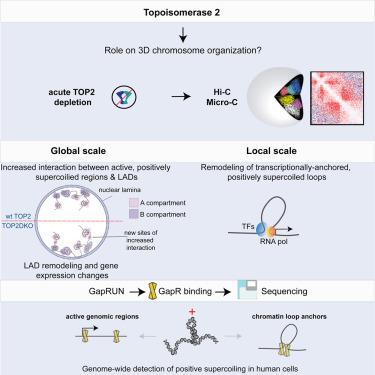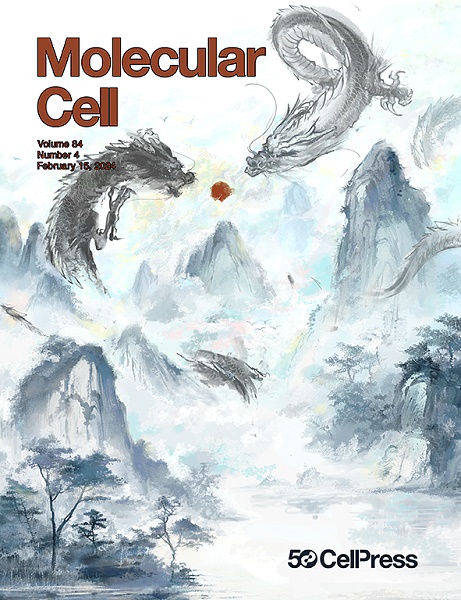II 型拓扑异构酶在正超螺旋区域形成多尺度三维染色质折叠
IF 14.5
1区 生物学
Q1 BIOCHEMISTRY & MOLECULAR BIOLOGY
引用次数: 0
摘要
II 型拓扑异构酶(TOP2s)可解决各种细胞过程中积累的扭转应力,并富集于染色质环锚和拓扑相关域(TAD)边界,一旦被困,可导致基因组不稳定,促进致癌融合的形成。TOP2 是否能缓解这些位置的拓扑限制和/或参与三维染色体折叠仍不清楚。在这里,我们结合三维基因组学、成像和 GapRUN(一种用于全基因组正向超螺旋剖析的方法)来评估 TOP2 在塑造人类细胞染色体组织中的作用。TOP2的急性耗竭导致活性、正超卷曲和片层相关结构域之间的边界出现了新的大规模接触。依赖于 TOP2 的高阶染色质折叠变化伴随着染色质-核薄层相互作用和基因表达的重塑,而在染色质环水平,TOP2 的耗竭主要重塑了转录锚定的正超螺旋环。我们认为,TOP2 在多个尺度上对染色体折叠起着精细调节作用。本文章由计算机程序翻译,如有差异,请以英文原文为准。

Type II topoisomerases shape multi-scale 3D chromatin folding in regions of positive supercoils
Type II topoisomerases (TOP2s) resolve torsional stress accumulated during various cellular processes and are enriched at chromatin loop anchors and topologically associated domain (TAD) boundaries, where, when trapped, can lead to genomic instability promoting the formation of oncogenic fusions. Whether TOP2s relieve topological constraints at these positions and/or participate in 3D chromosome folding remains unclear. Here, we combine 3D genomics, imaging, and GapRUN, a method for the genome-wide profiling of positive supercoiling, to assess the role of TOP2s in shaping chromosome organization in human cells. Acute TOP2 depletion led to the emergence of new, large-scale contacts at the boundaries between active, positively supercoiled, and lamina-associated domains. TOP2-dependent changes at the higher-order chromatin folding were accompanied by remodeling of chromatin-nuclear lamina interactions and of gene expression, while at the chromatin loop level, TOP2 depletion predominantly remodeled transcriptionally anchored, positively supercoiled loops. We propose that TOP2s act as a fine regulator of chromosome folding at multiple scales.
求助全文
通过发布文献求助,成功后即可免费获取论文全文。
去求助
来源期刊

Molecular Cell
生物-生化与分子生物学
CiteScore
26.00
自引率
3.80%
发文量
389
审稿时长
1 months
期刊介绍:
Molecular Cell is a companion to Cell, the leading journal of biology and the highest-impact journal in the world. Launched in December 1997 and published monthly. Molecular Cell is dedicated to publishing cutting-edge research in molecular biology, focusing on fundamental cellular processes. The journal encompasses a wide range of topics, including DNA replication, recombination, and repair; Chromatin biology and genome organization; Transcription; RNA processing and decay; Non-coding RNA function; Translation; Protein folding, modification, and quality control; Signal transduction pathways; Cell cycle and checkpoints; Cell death; Autophagy; Metabolism.
 求助内容:
求助内容: 应助结果提醒方式:
应助结果提醒方式:


